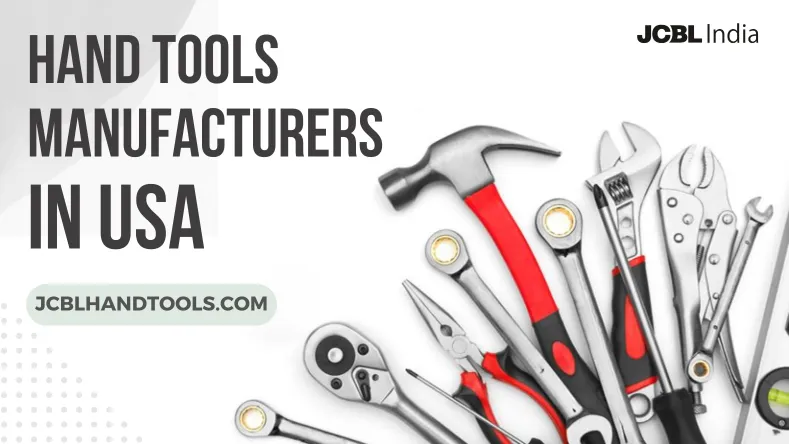Classification Of Hand Tools – A Comprehensive Guide

Since the ages, hand tools have applications in craftsmanship, construction, and household maintenance. Over the years, a variety of powerful tools came into existence but the importance of hand tools has been inevitable due to their precision, simplicity, and control. Individuals from construction, woodworking, and electronics to the automotive industry have been using hand tools to perform a variety of tasks. Whether you are a professional mechanic or just a DIY enthusiast, understanding the classification of hand tools based on their function and uses in different industries is essential. This not only helps you to select the right tool for your job but completes the task effortlessly.
In this blog, we will be providing a detailed classification of hand tools based on their function and explore specialized tools. This will help to guide you choose the right hand tool for your task.
What Are Hand Tools?
Hand tools are hand-operated tools that are operated manually without the use of a motor or electricity. They solely rely on the physical effort of the individual to perform tasks such as cutting, tightening, chopping, sawing, forging, striking, or measuring, etc. Pliers, wrenches, hacksaws, vises, clamps, files, cutters, etc are examples of hand tools.
People often can’t differentiate between hand tools and power tools. Power tools are powered with batteries, electricity, or air compressors. Unlike power tools, hand tools do not require external energy to work and they offer great precision and control.
Classification Of Hand Tools Based On Their Functions
By understanding the classification of hand tools, the user can pick the right tool for the different jobs to ensure safety, efficiency, and precision. Here is the classification of hand tools based on their use and functions:
Cutting Tools
Cutting tools are hand tools that can cut through other materials like wood, plastic, metal, or fabric. One can use them to cut, carve, shape, or remove material. Examples of cutting tools include hack saws, knives, chisels, and scissors.
- A hack saw is a sharp tool that can cut plastic, wood, metal, and other materials. Rip saws and cross-cuts are different types of hand saws that provide different cuts to your needs.
- Chisels have applications for cutting or carving hard materials like stone, wood, and metal.
- Utility knives are used for precision cutting in tasks like box opening, trimming edges, and paper cutting.
Striking Tools
You can use striking tools to hit or strike the objects. Their design allows one to deliver the force to drive another object like nails and chisels, or to break something apart. Industries including construction, metalworking, and woodworking widely use such types of tools. The most commonly used striking tools are hammers, mallets, and punches.
- A hammer is the most basic striking tool that one can use to drive nails into wood or other materials. They are of different types such as ball peen hammers, ball pein hammer, claw hammers, and sledge hammers.
- Mallet has applications in carpentry and woodworking to apply force on the object without damaging the material. They are softer than hammers, due to the use of rubber and wood material.
- Punch is used to make a hole to drive fasteners or form an indentation and patterns.
Holding And Gripping Tools
Holding and gripping tools are important for securing the materials while working. Such tools allow users to hold items tightly or provide extra force to tighten or loosen the object. The uses of holding and gripping tools vary from gripping and holding to manipulating objects. Most common holding and gripping tools include vices, locking pliers, and clamps.
- Pliers have applications ranging from gripping, bending, or cutting the wire and other materials. Industrialists use different types of pliers based on their needs such as long nose pliers, locking pliers, and slip joint pliers.
- Vices is a mechanical device with two jaws that allow the user to hold the object securely. You can easily find them in workshops.
- A clamp is a versatile hand tool that one can use to hold large objects securely in place. It has applications in carpentry, furniture making, welding, woodworking, etc.
Driving Tools
These tools have uses where one has to apply torque to tighten or loosen fasteners such as screwdrivers, bolts, and nuts. These have applications in automotive repair, construction, and home maintenance and improvement. Common examples of driving tools such as wrenches, screwdrivers, Allen keys, etc.
- Wrenches allow users to apply torque to nuts and bolts to tighten or loosen them. They come in different varieties such as box end wrenches, adjustable wrenches, and combination wrenches.
- Screwdrivers are used to insert and remove screws. They have different types to fit into different screw heads such as flathead, torx, and Phillips.
Measuring And Marking Tools
From construction and automotive to carpentry and metalworking, accuracy is critical. Professionals and DIY enthusiasts use measuring and marketing tools to measure and mark materials to ensure precision before cutting and assembling them. A few examples of measuring and marketing tools include tape measures, calipers, and rulers.
- A tape measure is a retractable measuring tool that is used to measure distance and dimensions.
- A caliper is a precision measuring tool that allows one to measure the distance between two opposite ends of the object.
- A ruler is used to measure and mark the straight line. It is common in carpentry and metalworking.
Sharpening And Abrasive Tools
These tools are specially designed to sharpen the edges of objects or smooth surfaces. Sharpening tools are important for cutting tools, whereas abrasive tools are useful to smooth and polish the materials. A few examples of sharpening tools include files, sandpaper, and whetstones.
- Files are used to remove the fine materials from a workpiece to sharpen or smooth its edges.
- Whetstones are used to sharpen cutting tools such as chisels, and knives by grinding their edges.
Impact And Demolition Tools
The key applications of impact and demolition tools are breaking, prying, and demolishing the materials. They have uses in heavy-duty applications such as construction and demolition work. Common impact and demolition tools include crowbar and sledgehammer.
- A crowbar is a lever-type tool that allows one to easily remove nails and pry objects apart.
- A sledgehammer is a large hammer that can break through materials such as walls and concrete.
Specialized Handtools
Most of the hand tools can be used across different industries, but there are a few industry-specific hand tools. Specialized hand tools meet the needs of unique tasks in automotive repair, carpentry, electrical work, or plumbing.
Automotive Hand Tools
Handtools including piston ring compressors and torque wrenches are the automotive handtools. Further, these can handle the tasks of automotive repair and maintenance such as tightening or loosening the nuts and bolts up a precise torque specifications. Also, technicians use them to install piston rings in the engine.
Carpentry Hand Tools
Planes and carving tools are the carpentry tools. Carpenters use these tools for furniture making and woodworking. The key use of hand planes is to smoothen the wooden surface. Meanwhile, carpenters create intricate designs in the wood using carving tools.
Electrical Hand Tools
The electrical hand tools have applications in electrical installations and repairs. Wire strippers, multimeters, and crimpers are examples of electrical hand tools. Electricians use them to strip the wire insulation, and crimp connectors, and measure electrical properties such as voltage and resistance.
Plumbing Hand Tools
Plumbing tools such as pipe wrenches and plumbers’ snakes have applications in plumbing installations and repairs. You can use pipe wrenches to grip and turn pipes, whereas you can clear out blockages in drains using plumbers’ snakes.
How To Choose The Right-Hand Tools For The Job
As there are a variety of hand tools available in the market, selecting the right one for your needs is important. Using the right tool for completing the job can make a huge difference in the quality of your work and efficiency. Here are a few factors that one should consider while choosing hand tools-
- Selecting a high-quality tool is important. You can choose alloys and hardened steel hand tools as they are capable of withstanding wear and tear in extreme working conditions.
- A tool with a comfortable grip and ergonomic design is important for tasks that require prolonged use. Make sure the tool you are selecting has cushioned handles as it can affect your productivity.
- Make sure that you select the tool that meets your specific needs as there are a variety of multifunctional and highly specialized tools available in the market.
- Select the right-sized tool for the job. For example, if you use a screwdriver that doesn’t properly fit the screw head can damage the tool, as well as the workpiece.
Conclusion
Despite the advancement in modern power tools, hand tools have remained an essential part of human civilization. Whether you want to cut, grip, strike, or measure, knowing the right tool for the job is important for completing the tasks. By understanding the classification of different hand tools based on their functions and specialization, you can select the right tool for your needs.
Whether you need a plier, hammer, crowbar, or other industrial hand tools, you don’t have to search further. At JCBL Hand Tools, you can get a variety of hand tools ranging from carpentry, and automotive, to building and other garage tools. We manufacture and supply hand tools across countries that meet international quality standards. Visit our website to check our complete range of hand tools.
FAQ’s
Is the plier a cutting tool or a gripping tool?
You can use a plier for both cutting and gripping purposes depending on its type. There are different variations of pliers available in the market such as needle nose, locking, diagonal, and slip joint pliers.
Can I use hand tools in any application area or industry?
Hand tools come in different varieties and they are versatile. It means that you can use them across different industries for fastening, measuring, cutting, and shaping. However, some hand tools are industry-specific and you can only use them in specific industries such as crimpers, planes, pipe wrenches, etc.



